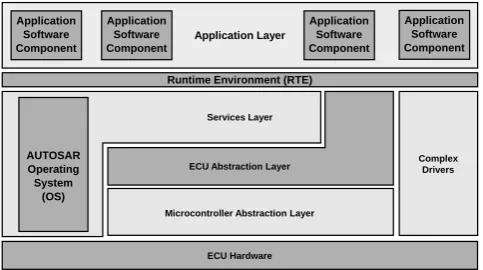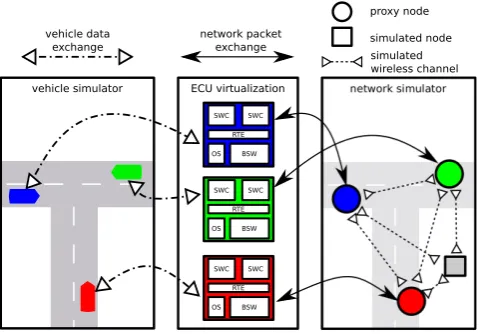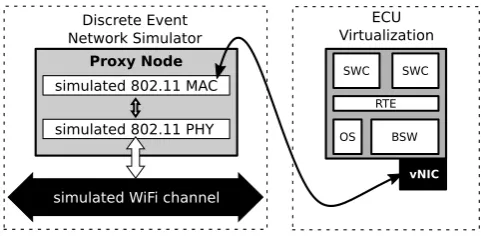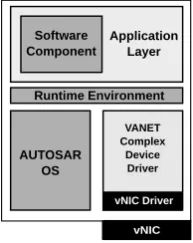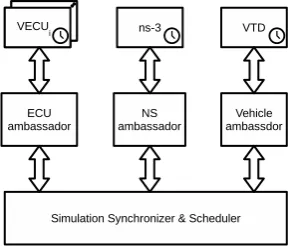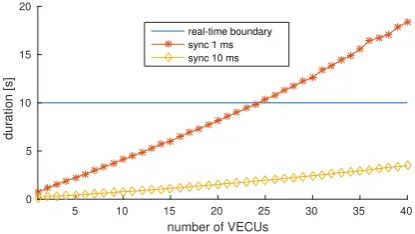Emulating Vehicular Ad hoc Networks for Evaluation and
Testing of Automotive Embedded Systems
Manuel Schiller, Alois Knoll
Robotics and Embedded SystemsDepartment of Informatics Technische Universität München
{manuel.schiller,knoll}@in.tum.de
ABSTRACT
The evaluation and testing of cooperative applications based on Vehicular Ad hoc Networks (VANETs) in real testbeds is difficult due to the need for repeatable scenarios and large-scale experiments. Therefore a novel virtualization-based framework is presented to evaluate automotive software in the context of emulated VANETs. The approach enables the precise and large-scale evaluation of real-world implementa-tions through the synchronized execution of network and vehicle simulators as well as the applications encapsulated in virtual Electronic Control Units. This paper provides a detailed description of the framework’s structure and its components as well as an validation of the proposed syn-chronization algorithm. The performance comparison with pure network simulation indicates that despite additional overhead large-scale experiments can be conducted without loss of accuracy.
Keywords
VANET, embedded system simulation, testing, evaluation, network emulation
Categories and Subject Descriptors
I.6.5 [Simulation and Modeling]: Model Development; I.6.7 [Simulation and Modeling]: Simulation Support
Systems; C.2.1 [Computer-Communication Networks]:
Network Architecture and Design—Wireless communication
1.
INTRODUCTION
Vehicular Ad hoc Networks (VANETs) have attracted a lot of research attention over recent years due to the potential improvements in traffic safety and efficiency as well as driver comfort. A high variety of applications, commonly referred to as Advanced Driver Assistance Systems (ADAS), such as cooperative driving and subsequently automated driving, are enabled through wireless ad hoc communication between the vehicles on the road.
Simulation is currently the key methodology to gain an un-derstanding of the various effects that influence the per-formance and behavior of the entire system composing a VANET. The majority of publications focuses on exploring the lower-level effects such as wireless signal propagation at the physical layer, medium access control and ad hoc rout-ing protocols. The actual applications which are intended to run on top of these layers are usually either left out com-pletely or are only modeled on a very abstract level. How-ever, these applications, which often exhibit safety-critical features, need to be evaluated and tested extensively before deployment in series production.
While it is theoretically possible to develop simulation mod-els of the actual implementations and execute them in the established simulators, this approach quickly gets infeasible for complex real world applications. At the other end of the spectrum of available methods real world test drives using physical testbeds of prototype vehicles offer the highest de-gree of realism. Due to the large amount of resources needed for real world test drives, this method is not feasible to per-form large-scale and extensive testing of vehicular networks. Additionally, achieving repeatable test conditions is next to impossible. In the automotive industry the use of simulation is well established in the development process of traditional driver assistance and active safety systems. However, the current emphasis is primarily on the simulation of individual vehicles at a very high level of detail [6]. When investigating and evaluating the performance of ADAS based on vehicu-lar communication, this isolated view of a single vehicle in the simulation is not sufficient anymore. Potentially every vehicle equipped with wireless communication technology is coupled in a feedback loop with the other road users par-ticipating in the vehicular network. Therefore the number of relevant intelligent entities which need to be taken into account is drastically increased.
To help bridging this gap we present in this paper a new virtualization-based approach for emulating vehicular ad hoc networks as the enabling methodology for evaluating and testing network-centric automotive embedded systems based on this wireless communication technology. Our approach ensures that the actual implementations rather than models are employed in the test procedure taking into account the overall system context. By eliminating the need to create such simplified abstractions, testing can be performed earlier and without potential mismatches between the application and its model.
SIMUTOOLS 2015, August 24-26, Athens, Greece Copyright © 2015 ICST
Complex Drivers
ECU Hardware Microcontroller Abstraction Layer
Services Layer
Application Layer
AUTOSAR Operating System
(OS)
Runtime Environment (RTE)
ECU Abstraction Layer
Application Software Component
Application Software Component
Application Software Component
Application Software Component
Figure 1: Overview of the AUTOSAR layered archi-tecture
The remainder of this paper is organized as follows: The testing and evaluation of real-world implementations of ADAS imposes a certain set of additional requirements, which are discussed in section 2 before giving an overview of the re-lated work. The general concept and architecture of our emulation approach are described in section 3. In section 4 we evaluate the performance and scalability of our approach by means of an exemplary scenario and discuss its benefits and limitations. Section 5 concludes the paper and gives an outlook of future work.
2.
BACKGROUND AND RELATED WORK
Before we proceed to the discussion of related work, it is es-sential to illustrate our scope and area of application as well as the resulting requirements. In order to evaluate and val-idate real implementations of ADAS in a simulated, virtual environment, a holistic view of the vehicular ad hoc network comprising the three domains vehicle, network and applica-tion is necessary. In contrast to existing approaches we aim to not only cover the network characteristics but also the be-havior of the vehicles and the network-aware applications in high fidelity. A high fidelity representation of an application means that the actual code as well as the context in which it is executing must be integrated into the overall simulation.
Unlike traditional PC-based software, driving assistance sys-tems are typically executed on embedded hardware plat-forms and must comply with hard real time requirements. A specific software architecture called AUTOSAR was de-veloped by the automotive industry for this specific purpose, which defines a generalized architecture for Electronic Con-trol Units (ECUs). As shown in figure 1 this model features a separation into multiple layers. AUTOSAR also contains the definition of an embedded real time operating system as well as the possibility to define custom interfaces and runtime be-havior in a formal description. The different components of an ECU, e.g. Application Software Components (SWC), can be developed separately from each other and are combined to the desired overall functionality later on. A key benefit of AUTOSAR is the standardization of hardware abstrac-tion layers, which enables hardware-independent develop-ment and portability of the majority of an ECU’s software. We will exploit this hardware abstraction in our emulation framework to provide a realistic execution environment for the evaluation of network-based applications.
In order to state the fundamentals of this investigation we give a brief overview of existing approaches for VANET sim-ulation and network emsim-ulation in the following sections.
2.1
VANET simulation
The usual strategy to simulate VANETs found in literature is to bidirectionally couple a network simulator and a mi-croscopic traffic simulation. Following this approach the in-teractions between road traffic and network protocols are represented and the mutual impact can be explored [15, 12].
A number of VANET research simulation frameworks which employ this coupling strategy have been developed. They allow researchers to focus on their specific area of inter-est, i.e. low-level networking such as medium access or high-level concepts of applications such as lowering CO2-emissions or reducing traffic jams. In Veins [15] the ap-plication behavior is directly incorporated into the network simulator as a high-level and simplistic model. While VSim-RTI [13] and iTETRIS [11] provide specific interfaces for in-tegrating VANET applications into the simulation context, adapting real-world implementations of automotive embed-ded software to these interfaces requires code modifications.
Since large-scale simulations are usually conducted to per-form a statistical analysis of the simulation results, efficient but rather simplistic microscopic traffic simulators are used to generate realistic mobility models. When testing and evaluating real ADAS implementations a more detailed rep-resentation of a vehicle’s state including its sensors and ac-tuators in the simulation is absolutely vital.
2.2
Network Emulation
Network simulation and real world testbeds are the usual methodologies for evaluating network protocols and appli-cations. Due to the simplifications performed in simulators regarding application models as well as the costs and insuf-ficient repeatability in testbeds, it is desirable to combine the strengths of both methodologies in a network emulator.
The original definition of network emulation by Fall [5] cov-ers the real time coupling of a discrete event network simula-tor and hardware executing real implementations of software prototypes. In a wider sense, network emulation can be de-fined as a hybrid experiment technique that combines both real and simulated network components withreal referring to either hardware or software components [1, p. 14].
systems such as Linux is widely established for evaluating PC-based software, however this methodology is yet novel in the research area of automotive embedded systems and inter-vehicular networks.
3.
EMULATING VEHICULAR AD HOC
NET-WORKS
We now present the design and implementation of our em-ulation framework. After describing the overall concept we explain in detail the four components of which the frame-work is composed.
3.1
Conceptual overview
Our framework is designed to provide a generic emulation platform for evaluating real implementations of ADAS which are based on vehicular network communication. The main goal is the support of executingunmodified applications in ahigh-fidelity and accurate representation of the VANET. The underlying concept is based on the feedback coupling of detailed subsystems for each of the relevant domains consti-tuting a VANET, i.e. the physical domain of each vehicle, the logical domain embodied by the applications running on the ECUs as well as the communication network connecting the vehicles through the wireless channel. Figure 2 shows the three relevant domains as well as the data flows between those subsystem representations in a conceptual overview of the emulation framework. For reasons of clarity, the data flow from vehicle simulator to network simulator is not de-picted but the node positions in the network simulator are kept consistent with the vehicle simulator.
SWC SWC RTE
OS BSW
SWC SWC RTE
OS BSW SWC SWC
RTE
OS BSW
vehicle simulator network simulator network packet
exchange
proxy node
simulated wireless channel simulated node vehicle data
exchange
ECU virtualization
Figure 2: Conceptual overview of the emulation
framework
In order to allow evaluation and testing of unmodified ap-plications, the emulation framework needs to provide an ex-ecution environment which is as close as possible to the real system on which the applications will be deployed in se-ries production. This could be achieved by representing the logic domain by real hardware ECUs executing the software prototypes. However, this approach is infeasible for the fol-lowing reasons:
The development process in the automotive industry is char-acterized by concurrent engineering in order to shorten the
time to market. In the given context this especially covers the parallel design and development of both ECU hard- and software, which results in only relatively late availability of the hardware and would thus delay testing of the software prototypes. Additionally, conducting large-scale scenarios would require a large number of ECUs as well as a high logistic effort for setting up and performing the actual ex-periments. Last but not least, the aforementioned simula-tor overload resulting from complex models and high node counts in the network simulator can invalidate the evalua-tion results.
For these reasons we choose to integrate virtualized ECUs (VECUs) as the representation of the logical domain into the overall emulation framework. This approach solves the dependency on hardware availability and the scalability is-sues and allows us to decouple the emulation from the real time constraint by synchronizing the time progression of the software prototypes with the execution speed of the other simulators.
3.2
Network Simulation
The network simulation is used to model the wireless com-munication network connecting the vehicles and the applica-tions running on their ECUs. As shown in figure 2 each vir-tual ECU is represented by a proxy node in the network sim-ulation domain. The proxy node acts as a communication endpoint to initiate the simulated transmission of network packets as well as to receive network packets transmitted by other network nodes. Additionally, fully simulated nodes can be included, which may for example represent intelligent infrastructure such as traffic lights.
We apply the vertical emulation concept which is defined in [7] and also referred to as a split stack in [14]. The net-work stack is separated into two parts where the upper layers (including the application layer) belong to the VECUs, while the lower layers are realized by the network simulator. To offer the highest degree of generality and flexibility, the em-ulation boundary, i.e. the layer at which the network stack is split up, is drawn at the Medium Access Control (MAC) layer. This allows to evaluate arbitrary routing and trans-port layers as well as the application functionality, which are typically implemented in software and executed in the VECU. Network packets generated by these layers are cap-tured at the virtual Network Interface Controller (vNIC), which is described in the next section. The packets are then injected into the corresponding proxy node, traverse the simulated MAC and physical (PHY) layer and are then potentially received in reverse order at other nodes after the simulated transmission has been performed by the network simulator. The proxy nodes therefore handle all lower layer functionality that is usually performed by hardware. This hybrid emulation approach is shown in figure 3.
simulated WiFi channel
Discrete Event Network Simulator
ECU Virtualization
simulated 802.11 PHY simulated 802.11 MAC
Proxy Node
vNIC
SWC SWC
RTE
OS BSW
Figure 3: Hybrid Vehicular Ad hoc Network Emu-lation
The event-driven network simulator ns-3 is chosen to per-form the actual network simulation of the wireless commu-nication domain. ns-3 features an open-source modular ar-chitecture that can be extended quite easily. A rich number of simulation models is already available in ns-3, of which we employ the WiFi models and specifically the 802.11p MAC layer model [2]. Network packets in ns-3 are repre-sented as binary packets in network byte order that match their real-world counterparts, so it is possible to directly ex-change packets between simulation nodes and external sys-tems without the need for any packet translation through the proxy nodes and a custom data-exchange interface.
To allow synchronization of the network simulator with the other domain representations we implemented a custom event scheduler which can be controlled from the outside. In con-trast to the default implementation this scheduler executes only those events whose associated simulation time is below a given boundary in virtual time. When this boundary time is reached or a network packet is received by a proxy node, event execution is suspended and the time of the next event in the network simulator’s queue is reported to the outside. The synchronization algorithm is described in detail in sec-tion 3.5.
3.3
ECU Virtualization
As described in section 3.1 our emulation platform is based on the virtualization of ECUs. While there are various ap-proaches available for virtualizing such embedded systems, the method of choice is justified by two main reasons. The fi-nal hardware design of an ECU is usually determined rather late in the development cycle. Therefore important details such as processor architecture, core count etc., which are vi-tal for a detailed modeling of the underlying hardware, are missing until the hardware is specified. Additionally, de-tailed instruction set or even cycle-accurate simulations re-quire a high computational effort, which conflicts with our goal to conduct large-scale evaluations.
We have thus chosen the rather hardware abstract approach ETAS Virtual ECU1 which allows us to put the emphasis not on one single, highly-detailed modeled ECU but on the overall system of connected vehicles. This tool enables us to create virtual ECUs based on a formal AUTOSAR archi-tectural model and the hardware independent C code. This approach can be described as host-compiled
paravirtualiza-1
http://www.etas.com/en/products/isolar eve.php
tion [3] where the hardware-abstraction layers of AUTOSAR are exploited by porting those abstraction layers as well as an AUTOSAR compliant operating system to a standard PC operating system such as Linux. This allows the exe-cution of a VECU on a traditional desktop PC on top of the host operating system rather than interacting directly with the actual hardware. A VECU is compiled into a self-contained executable that can be instantiated as often as necessary, which enables performing large-scale evaluations. Each VECU is run as a separate process which has its own virtual hardware (e.g. interrupt controller) modeled on an abstract functional level.
In the following we describe the execution concept of a VECU. The execution is stimulated by an internal clock or through virtual interrupts. The internal clock can either progress with respect to the wall clock when running in real-time mode or clock ticks can be injected from the outside, which allows full control over the execution of the VECU. Due to the fact that the virtual ECU is executed only on a rather abstract hardware model and since the compiler for the host PC is different from that of the target platform, the exe-cution durations of individual tasks are not representative. We thus interpret the execution of VECU tasks as discrete events which means that a task is executed by an infinitely fast processor in terms of simulated time, as time does not progress during the execution of a task. This assumption leads to the fact that preemption of tasks by higher prior-ity tasks or interrupts does not occur, however considering these scheduling effects only makes sense if a more detailed model of the target platform is available.
0
priority
ISR
Task5ms
Task10ms
time (ms)
5 10 15 20
execution
time preemption interrupt
discrete event activation
1
2
3
4 7
5
6
8
Figure 4: Timing behavior comparison of virtualized ECU
under test because influences stemming from the host oper-ating system do not have an impact on the timing behavior of the virtual system.
A VECU can communicate with the outside world through virtual hardware devices. Since there is yet no standardized integration of VANET hardware in the AUTOSAR architec-ture we have integrated the virtual wireless network interface (vNIC) using a complex device driver as shown in figure 5. The vNIC redirects the network packets originating from the VECU to the corresponding proxy node in the network simulator. It also offers the interface to inject network pack-ets into the VECU which have arrived at the proxy node. When a packet is injected into the virtual network device, an interrupt in the VECU is raised and in the corresponding ISR the packet can be handled by a custom network stack implementation and the AUTOSAR software components.
VANET Complex
Device Driver Application
Layer
AUTOSAR OS
Runtime Environment Software
Component
vNIC Driver
vNIC
Figure 5: Integration of the virtual network device into the VECU architecture
3.4
Traffic And Vehicle Simulator
As stated in section 2.1 the microscopic vehicle models which are usually employed for conducting VANET simulations are not detailed enough for our purpose. The vehicle dynamics as well as actors and sensors need to be modeled in sufficient detail and accuracy in order to supply all necessary state variables to the real implementation of the ADAS under evaluation.
We therefore employ the nanoscopic traffic and vehicle sim-ulator VIRES Virtual Test Drive (VTD) for the high-fidelity simulation of the physical domain of the vehicles. VTD has been developed for the automotive industry as a virtual test environment used for the development of ADAS [18]. Its focus lies on interactive high-realism simulation of driver behavior, vehicle dynamics and sensors. VTD is highly modular, so any standard component may be exchanged by a custom and potentially more detailed implementation. Its standard driver model is based on the intelligent driver model [17], however an external driver model may be applied if necessary. The same concept applies for the vehicle dy-namics simulation, where the standard single-track model can be substituted by a complex vehicle dynamic model adapted for specific vehicles. Each simulated vehicle can be equipped with arbitrary simulated sensors, for example RADAR sensors or synthetic video cameras. VTD offers proprietary interfaces to control the simulation execution in a time driven manner as well as to extract the simulation state after the computation of a simulation step.
3.5
Simulation Synchronizer & Scheduler
The three described domain representations are either time-driven (vehicle simulator), event-time-driven (network simulator) or both (VECUs). In order to achieve a deterministic co-simulation comprised of all three domains, the subsystems must be synchronized. The Simulation Synchronizer & Sched-uler (SSS) ensures that the execution of the subsystems is synchronous so that no time drifts can occur as well as causality errors, i.e. executing events from the past, are avoided. Since none of the system representations allows to perform rollbacks, an optimistic synchronization algorithm cannot be used; we therefore choose a conservative synchro-nization algorithm.
SSS maintains a global event list to determine which system representation is to be scheduled next. After the execu-tion of a system representaexecu-tion is completed, this system is rescheduled when it is due the next time. The determination of thisnext timedepends on the respective system. The ve-hicle simulator is scheduled once every time stepTvehwhich is configurable for the vehicle simulator. The execution of the VECUs can be scheduled every tickTtick which corre-sponds to the time resolution of the VECUs as described in section 3.3. In order to reduce synchronization overhead, the task activation behavior of the VECUs, which is contained in the AUTOSAR architectural model, can be exploited. If a VECU’s minimum task activation period isTvecu,min, this value can serve as the rescheduling period without sacrific-ing accuracy. The custom scheduler implementation of the network simulator reports its next event time as described in section 3.2 which serves as the next event time in the global event list of SSS for the network simulator. In order to avoid causality errors, the network simulator is only al-lowed to progress in virtual time until the next VECU will be executed again. This boundary is also derived from the global event list.
We illustrate the synchronization algorithm by the sequence diagram in figure 6, which shows the exemplary scenario of two VECUs which send ping requests and replies over a simulated wireless channel. For reasons of simplicity the vehicle simulator is left out. The transmission durations in this example are purely fictional and listed for demonstrative purposes only. The VECUs in this example exhibit a task activation period ofTvecu,min=Ttick= 1.0 ms.
Initially the two VECUs execute one tick of virtual time in parallel. VECU2 sends a ping request at time t = 1.0 ms
contained in network packetpto VECU1. Packetpis
cap-tured at the vNIC of VECU2 and is then sent to SSS which
forwards it to the network simulator. This causes the en-queuing of an ns-3 event which injects the packet into the network simulation at t = 1.0 ms through the proxy node associated with VECU1. ns-3 is now allowed to execute
events untilt = 2.0 ms, which leads to the transmission of p on the simulated wireless channel. At time t = 1.2 ms packet pis received at the proxy node, which corresponds to VECU1. This suspends the execution of events inside
the network simulator and packetpis delivered through the SSS to vNIC of VECU1, which triggers an interrupt. The
Figure 6: Synchronization of virtual ECUs and net-work simulation
In our implementation, the system representations do not communicate directly with each other but through the SSS. The underlying federation concept is derived from the High Level Architecture (HLA), a generic framework for distributed simulations [9]. Each system representation is connected to the SSS by means of a specific ambassador software compo-nent which is responsible for message exchange in both direc-tions as shown in figure 7. These messages involve both the synchronization and the exchange of simulation state data as depicted in figure 2. The ambassadors translate the mes-sages from SSS to the respective subsystem and vice versa. This allows to replace any given subsystem by either another software implementation or even by real hardware by mod-ifying just the corresponding ambassador. The flexibility of the architecture also makes it possible to add additional simulators to the overall simulation and to distribute the system representations on multiple machines.
Figure 7: Implementational overview of the emula-tion framework
4.
EVALUATION AND DISCUSSION
In the following we evaluate the proposed framework by means of a synthetic scenario to examine the timing accu-racy and performance with regard to scalability. We then discuss the universal applicability of our approach as well as its limitations.
4.1
Evaluation Scenario and Setup
The evaluation is performed by comparing the framework’s results and performance with pure network simulation. In order to achieve a good comparability we chose to use the previously described ping scenario with static node posi-tions. In this scenario there are n = 2k nodes where each node i ∈ [1, k] pings another node j ∈ [k+ 1, n] over a simulated 802.11p Wifi channel with an intervalvbetween requests. We integrated the open source IP stack lwip [4] (version 1.4.1) in the AUTOSAR VECU, which is straight-forward due to it being implemented in C. All experiments were carried out on a single machine equipped with an 3.6 GHz Intel Xeon CPU, 16 GB RAM on a 64 bit Linux 3.16 kernel using ns-3 version 3.22 and ETAS Isolar-EVE version 2.2.
4.2
Accuracy and Scalability
To validate the correct synchronization behavior of our global event scheduler we performed the above described scenario once in ns-3 alone without the SSS and any VECUs being attached, so all nodes were fully simulated. The same sce-nario was then run in our emulation framework with each node now configured as a proxy attached to a VECU in-stance. The transmissions were simulated on a 802.11p wire-less channel at 5.9 GHz. The node count was set to n= 20 and the ping interval to v= 10 ms. Figure 8 shows an ex-cerpt of the captured round trip times resulting from both the simulation and the emulation experiment between a cor-responding pair of nodes. The round trip times vary due to the interference of competing transmissions between the other node pairs on the shared wireless medium. The re-sulting round trip times are identical for both experiments, which demonstrates that the scheduling of VECUs and net-work simulation in our emulation framenet-work is performed correctly and deterministically.
simulation time [ms]
3000 3100 3200 3300 3400 3500 3600 3700 3800 3900 4000
round trip time [ms]
0 0.5 1 1.5 2 2.5
pure simulation emulation with VECUs
Figure 8: Round trip times in simulation and emu-lation
Before comparing performance of simulation and emulation we ran the scenario with network simulation disabled. This setup allows to examine the influence of the synchronization tightness by either scheduling the VECUs everyTtick= 1 ms or everyTvecu,min = 10 ms. Figure 9 shows the impact of the different synchronization periods. While 40 VECUs can be run synchronously in real time in our framework when using the 10 ms period, the synchronization overhead of the 1 ms period is clearly visible and the real-time boundary is crossed when executing more than 24 VECUs.
compar-number of VECUs
5 10 15 20 25 30 35 40
duration [s]
0 5 10 15 20
real-time boundary sync 1 ms sync 10 ms
Figure 9: Performance comparison of VECU syn-chronization periods
ison with the network simulation, which is introduced by our framework, we conducted a series of experiments with increasing node counts for both the simulation alone and the emulation and measured the real-time duration for each configuration. Each configuration was run 10 times for a duration of 10 s of simulated time and the number of node pairs k was increased from 1 to 24. Figure 10 shows the durations for the simulation in ns-3 alone as well as for the emulation with the two different synchronization periods of the VECUs when running the ping scenario with an inter-val ofv= 100 ms between ping requests. This results in a message frequency of 10 Hz, which is typical for cooperative awareness in VANET applications [8, p. 275].
The pure simulation obviously performs fastest since no ad-ditional synchronization is necessary. The synchronization overhead, which the emulation results exhibit, stems from the fact that the VECUs and the network simulation are exe-cuted sequentially when sending and receiving network pack-ets to guarantee a correct and deterministic co-simulation.
number of node pairs k
5 10 15 20
duration [s]
0 10 20 30 40 50
pure simulation emulation sync 1 ms emulation sync 10 ms
Figure 10: Performance comparison between simu-lation and emusimu-lation
The computational effort which is necessary to perform the network emulation depends on multiple factors. The syn-chronization period of the VECUs only shows a rather slight impact on the overall duration, whereas the number of nodes represented by VECUs as well as the amount of messages transmitted and received by VECUs affect the performance the most. Another factor, which is not examined here, is the actual workload of each VECU. If the ADAS under
eval-uation performs complex calculations, this will lead to an additional increase of computational requirements.
4.3
Discussion
The above shown evaluations state that our framework al-lows to accurately evaluate and test real-world implementa-tions of VANET applicaimplementa-tions. The overhead introduced by executing VECUs for each node as well as synchronizing the three subsystem representations leads to longer simulation durations. However since the simulation is decoupled from the real-time constraint, the accuracy of the results is not affected even when conducting large-scale experiments.
In the following we will discuss the universal applicability of the approach as well as its limitations.
The chosen virtualization method generally allows to inte-grate unmodified source code of the ADAS implementations. However, due to the paravirtualization it is necessary to compile the code to run on the x86 host architecture. Typ-ically, software components developed for the AUTOSAR architecture are written in ANSI C. Due to the AUTOSAR hardware abstraction layers, they are independent from the underlying hardware which allows to re-compile the code for the x86 architecture without code modification. However, if the standardized interfaces of the AUTOSAR architecture are bypassed somehow, the source code may need to be mod-ified. Additionally, if source code is not available, e.g. due to IP protection, closed source components can be integrated as precompiled x86 libraries.
While we focus on ad hoc communication based on IEEE 802.11p, our concept is agnostic to the underlying network topology and transmission medium. This allows to evaluate the network-based ADAS on other radio technologies such as ad hoc LTE only by changing the configuration of the network simulator to apply other simulation models for the PHY and MAC layer. In our examples we only consider one ECU per vehicle, however the approach is flexible enough to allow the integration of multiple ECUs per vehicle and, given that suitable models exist, even the simulation of intra-car networks such as CAN.
Since the chosen virtualization approach assumes no detailed knowledge of the target hardware, hardware characteristics which might influence the timing behavior are not taken into consideration. Delays which are caused by the target hardware are neglected, which is a limitation of our cur-rent implementation. We regard the modeling of hardware-introduced delays as future work which can be approached by instrumenting and tracing execution on real hardware platforms once they are available in the development pro-cess [10].
5.
CONCLUSION
network protocol and application implementations in the context of a realistic runtime execution provided by an AU-TOSAR compliant embedded operating system. A global simulation scheduler synchronizes the execution of all do-main representations to achieve a deterministic and correct experiment execution. The evaluation shows that the em-ulation generates accurate results by synchronously execut-ing the software components encapsulated in virtual ECU instances and the other simulators. The approach allows to perform detailed and large-scale evaluations early in the product development cycle without being dependent on the availability of real hardware.
As our next steps we plan to integrate an industry imple-mentation of a Car2Car communication stack into our pro-posed virtual prototype solution as well as tackle the area of hardware-in-the-loop simulation by combining both real and virtual ECUs.
6.
REFERENCES
[1] R. Beuran.Introduction to Network Emulation. Pan Stanford Publishing, 1st edition, 2012.
[2] J. Bu, G. Tan, N. Ding, M. Liu, and C. Son. Implementation and Evaluation of WAVE
1609.4/802.11P in Ns-3. InProceedings of the 2014 Workshop on Ns-3, WNS3 ’14, pages 1:1–1:8, New York, USA, 2014. ACM.
[3] J.-L. B´echennec, M. Briday, S. Faucou, F. Pavin, and F. Juif. ViPER: A Lightweight Approach to the Simulation of Distributed and Embedded Software. In Proceedings of the 3rd International ICST Conference on Simulation Tools and Techniques, 2010.
[4] A. Dunkels. Design and implementation of the lwip tcp/ip stack. Technical report, Swedish Institute of Computer Science, 2001.
[5] K. Fall. Network emulation in the vint/ns simulator. InProceedings of the fourth IEEE Symposium on Computers and Communications, pages 244–250, 1999. [6] O. Gietelink, J. Ploeg, B. De Schutter, and
M. Verhaegen. Development of advanced driver assistance systems with vehicle hardware-in-the-loop simulations.Vehicle System Dynamics, 44(7):569–590, 2006.
[7] E. G¨okt¨urk. Emulating ad hoc networks: differences from simulations and emulation specific problems. In New Trends in Computer Networks, volume 1 of Advances in Computer Science and Engineering: Reports. Imperial College Press, October 2005. [8] H. Hartenstein and K. Laberteaux.VANET Vehicular
Applications and Inter-Networking Technologies. Intelligent Transport Systems. Wiley, 1. edition, 2010. [9] IEEE. IEEE Standard for Modeling and Simulation
(M&S) High Level Architecture (HLA)– Framework and Rules, August 2010.
[10] S. Kristiansen, T. Plagemann, and V. Goebel. Modeling communication software execution for accurate simulation of distributed systems. In Proceedings of the 2013 ACM SIGSIM Conference on Principles of Advanced Discrete Simulation,
SIGSIM-PADS ’13, pages 67–78, New York, USA, 2013. ACM.
[11] M. Rondinone, J. Maneros, D. Krajzewicz, R. Bauza,
P. Cataldi, F. Hrizi, J. Gozalvez, V. Kumar, M. R¨ockl, L. Lin, et al. iTETRIS: a modular simulation platform for the large scale evaluation of cooperative ITS applications.Simulation Modelling Practice and Theory, 34:99–125, 2013.
[12] F. J. Ros, J. A. Martinez, and P. M. Ruiz. A survey on modeling and simulation of vehicular networks: Communications, mobility, and tools.Computer Communications, 43:1–15, 2014.
[13] B. Sch¨unemann. V2X simulation runtime
infrastructure VSimRTI: An assessment tool to design smart traffic management systems.Computer
Networks, 55(14):3189 – 3198, 2011.
[14] C. Serban, A. Poylisher, and J. Chiang. Virtual ad hoc network testbeds for network-aware applications. In Network Operations and Management Symposium (NOMS), 2010 IEEE, pages 432–439, Osaka, Japan, 2010. IEEE.
[15] C. Sommer, R. German, and F. Dressler.
Bidirectionally Coupled Network and Road Traffic Simulation for Improved IVC Analysis.IEEE Transactions on Mobile Computing, 10(1):3–15, 2011. [16] F. Sultan, A. Poylisher, J. Lee, C. Serban, C. J.
Chiang, R. Chadha, K. Whittaker, C. Scilla, and S. Ali. Timesync: Enabling scalable, high-fidelity hybrid network emulation. InProceedings of the 15th ACM International Conference on Modeling, Analysis and Simulation of Wireless and Mobile Systems, MSWiM ’12, pages 185–194, New York, USA, 2012. ACM.
[17] M. Treiber, A. Hennecke, and D. Helbing. Congested traffic states in empirical observations and microscopic simulations.Physical Review E, 62(2):1805, 2000. [18] K. von Neumann-Cosel, M. Dupuis, and C. Weiss.
Virtual test drive - provision of a consistent tool-set for [D,H,S,V]-in-the-loop. InProceedings of the Driving Simulation Conference, Monaco, 2009. [19] E. Weing¨artner, F. Schmidt, H. Vom Lehn, T. Heer,
